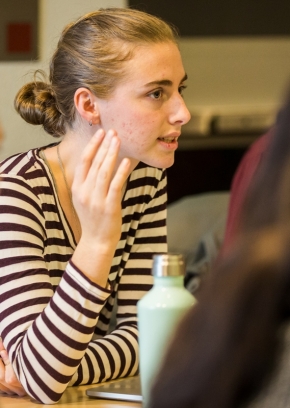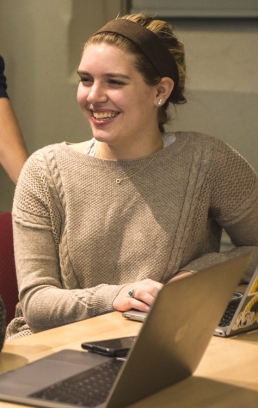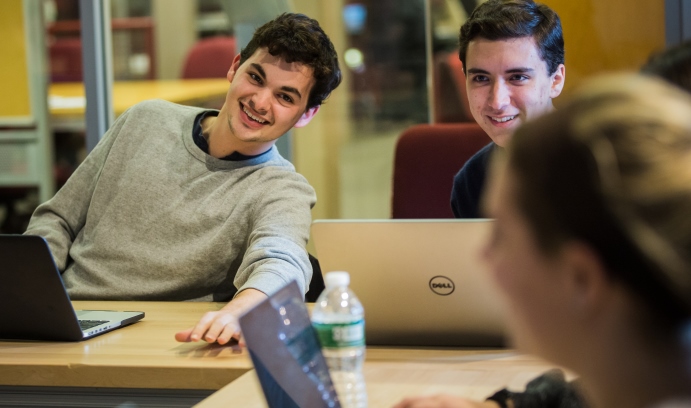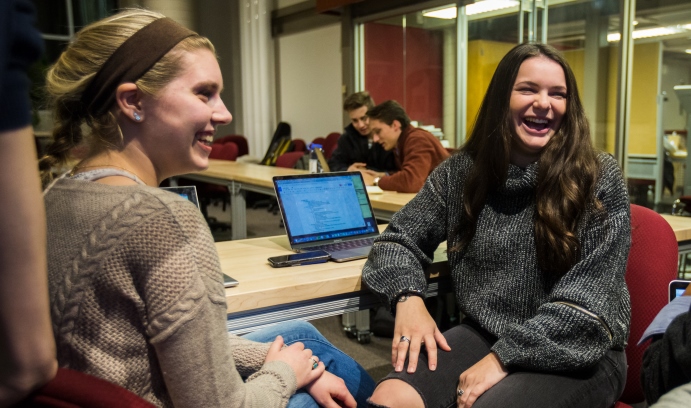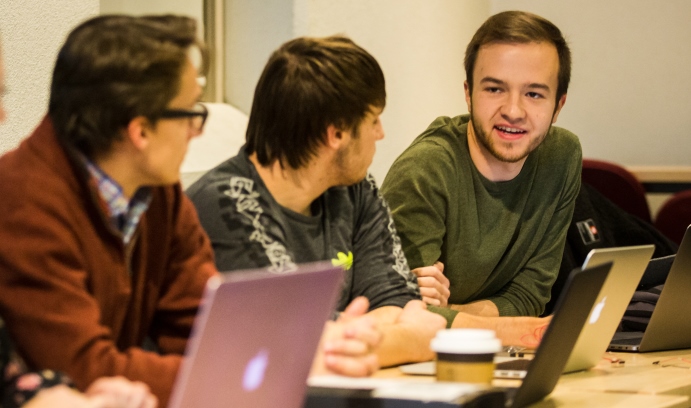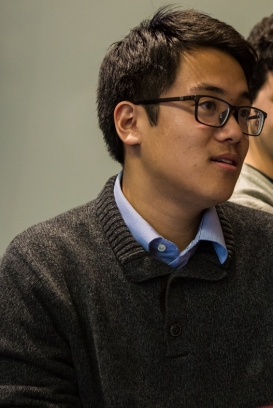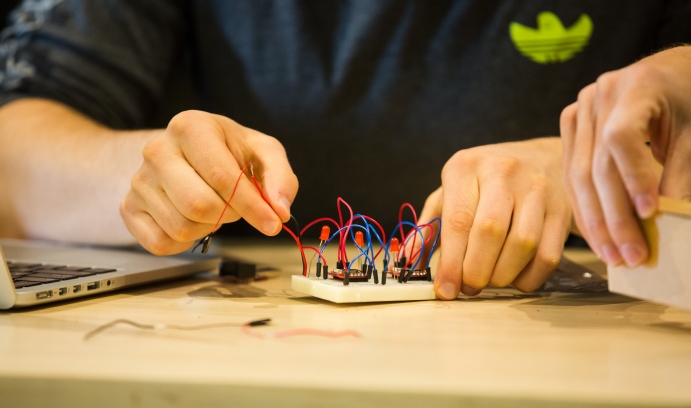Students to Compete in India for Jain Women’s Safety Prize
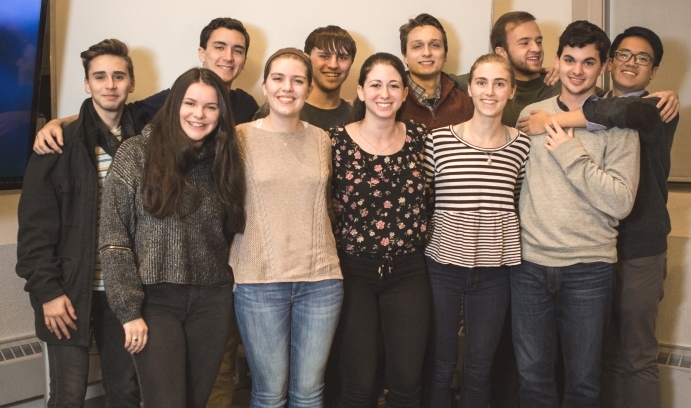
Lehigh’s Soterra students and 20 other teams have been chosen to compete in the semifinal round for the XPRIZE Foundation’s Jain Women’s Safety Prize. Left to right: Cameron Cipriano, Morgan Schurr, Ian Ferguson, Emily Randolph, Drew Siedel, Brooke Glassman, Chris Szafranski, Lena McDonnell, Stefan Gorski, Matt Ciolino and Michael Wu. Not pictured: John Cunningham, John Ott, Marta Kasica-Soltan.
As they strive to make life safer for women, 14 student entrepreneurs are drawing inspiration from two separate maps of the globe.
One map shows the regions of the world with the highest rates of violence against women. The other shows the regions where cell phones are common and where they are not.
The regions where cell phone ownership is lowest, the students point out, are the same regions where the rates of violence against women are highest.
The students hope to reduce those rates by offering women quick and reliable access to emergency response services. To do so, they are developing a device that makes innovative use of a relatively new wireless communications technology.
The device, like the students’ group, is called a Soterra. It fits in the palm of the hand or clips on clothing. The Soterra would allow women in a threatening situation to send an alert to friends and family or to the police—even if they don’t have a cell phone or access to the internet.
The Soterra team is competing for the $1 million Anu and Naveen Jain Women’s Safety Prize offered by the XPRIZE Foundation, a nonprofit that sponsors competitions to encourage innovators to come up with technological solutions to pressing problems.
Eighty-five teams from 17 countries entered the competition for the Jain Prize. Last month, the Lehigh group and 20 others were chosen to make presentations at the semifinal round next April in Mumbai, India.
The word Soterra, says Lena McDonnell ’18, a computer science major who is the group’s captain, combines the names of two ancient mythological deities. Soteria was the Greek goddess of safety, while Terra Mater was a Roman goddess of the land.
The Soterra group began working on their project in April 2017, continued over the summer and went into high gear to meet the September 15 deadline to submit technical design documents for the Jain Prize.
“We met for more than five hours a night, every night for four weeks,” says McDonnell.
“We believe we’ve created something amazing. Whether we win or lose, we’re not going to stop; we’re going to finish this project no matter what.”
“Our group,” says Matthew Ciolino ’18, a mechanical engineering major who leads the hardware team for Soterra, “has all the enthusiasm of a startup, the ideas of a think tank and the knowledge to build a product.
“Even before we heard that we had made it to the next round, we started funding research and development. We knew we had an incredible idea.”
A Dynamic, Low-Energy Network
The Soterra students have completed the design and much of the development of their device. The goal is to develop two prototypes. The first, a Bluetooth mesh networking solution now in development, will have a range of 500 to 1,000 feet. The group hopes later to design a radio frequency mesh networking solution with a range of up to two miles.
One of the keys to the Soterra, says Chris Szafranski ’18, who leads Soterra’s device team, is the innovative use it makes of wireless mesh networking. In a mesh network, infrastructure nodes such as bridges, switches or even laptops cooperate efficiently and in a non-hierarchical manner to relay data from one node to another. Szafranski, a computer engineering major, works with Stefan Gorski, a computer science major on leave from Lehigh who leads Soterra’s technical team.
A typical mesh network, says Szafranski, consists of a pre-determined number of nodes located in fixed positions. The Soterra network, by contrast, will be fluid, with individual nodes—Soterras—constantly moving around the network and in and out of it as well. The devices can maintain contact with each other as long as they are within a 500- to 1,000-foot range of each other.
Thus, says Szafranski, a message that is triggered at one device, or node, will be passed on to every device in the network until it reaches a device that has an internet connection. This device could be a cell phone installed with a Soterra app and messaging system. A Soterra could also be paired with a tablet that is connected to the internet.
“Our solution is designed to be low-energy and to allow women to be connected to help for as long as possible,” says Szafranski.
Another unique feature of the Soterra is that it offers two options to users who find themselves in a threatening situation. When the device is pressed twice, its sensors activate a yellow alert, which goes to a preselected set of contacts, such as friends and family members. When it is pressed three times, the sensors trigger a red alert, which goes to the police. The user is alerted when either type of signal is sent and received. The signal can also be cancelled by the user if the user no longer feels help is needed or has sent the wrong signal.
In the vast majority of sexual assault cases, says McDonnell, “the abuser is someone the victim knows. In almost all of these cases, the victim is unwilling to call police for fear of escalating the situation or because she doesn’t trust the police. Also, in some parts of the world, victims are blamed for a sexual assault that has occurred.”
The sensors, says Szafranski, give the Soterra greater discretion and speed than similar systems.
“Other solutions to this problem are primarily cellphone-based,” he says. “You take out your phone, tap on an app and send an alert. Our device offers a discreet button press that you can activate in your pocket.”
Because the Soterra network uses GPS, the students say, it will achieve a geographical accuracy up to 50 times greater than that achieved by a U.S. mobile 911 phone call that relies on cell tower triangulation.
Working on All Fronts
Much work remains to be done before the XPRIZE semifinals. By mid-April, the Soterra students must complete five working prototypes that successfully and reliably demonstrate proof-of-concept. The device they present at the semifinals in India must have a manufacturing cost of less than $40.
To meet those deadlines, the device team has to finish building the Soterra’s system architecture, a process that requires high-level state machine design as well as hands-on circuit building and wiring. The team is also utilizing API (application programming interface) and writing embedded programming code to run the device processor.
Meanwhile, the hardware team is using a CAD (computer-aided design) program to determine the ideal ergonomical shape of the device and 3D printing to test different materials.
“Designing a product for human use is very difficult to do when you are looking at your CAD program wondering what radius of curve fits most ergonomically into your hand,” says Ciolino. “Our team has had very long talks about what type of material the button should be in order to be the safest and best feeling.
“We can only get real feedback about how the device feels after we manufacture it. Since we are designing the product right now, 3D printing—and actually feeling different designs—is the best way we know of going through this design process.”
The Soterra students are also raising money to build and test prototypes and to pay for the trip to India.
“The biggest challenge I've faced is raising all of the capital we need for our project,” says Emily Randolph ’19, Soterra’s business manager, who studies industrial and systems engineering and finance as a major in Lehigh’s Integrated Business and Engineering (IBE) honors program.
“We’ve found a lot of success with the Soterra Ignite page and fundraising through the Baker Institute, but we are trying to develop many working prototypes to test our mesh network as well as travel to India to present our product.
“Fortunately, we have an incredibly bright and dedicated team as well as an amazing support network from Lehigh and friends and family.”
For visuals, graphics and publicity, the Soterra team relies on Michael Wu ’20, a bioengineering and marketing major in the IBE program.
“My job is to be able to present our content in a way that highlights our technology and solution, while making it understandable and relatable from the perspective of a donor,” says Wu. “The most difficult thing is to satisfy everyone’s wants and concerns. Having to grind through hours upon hours of revisions in Photoshop and Illustrator from team suggestions is definitely an arduous task; however, I am very excited to be a part of this team and hope to be able to make a difference in the world.”
Four members of Soterra are XPRIZE veterans. Ciolino, Wu, Randolph and Brooke Glassman ’19, a mechanical engineering major, took part in last year’s Shell Ocean Discovery XPRIZE competition to design and build an autonomous underwater vehicle capable of mapping the ocean floor. Their group, called Lehigh Tide, also advanced to the semifinals.
This year, whether or not they win the Jain Prize, the Soterra members say they have already gained much from their experience.
“It’s a lot of fun to work on a project with such potential significance in the real world,” says Szafranski. “The prize is not the biggest factor; instead, this is about creating a technology that can really help people.”
“One of the most impactful things that I have experienced from this project,” says Wu, “are the bonds that you build with everyone you work with. Although you may work on an in-class project, there are very rare occasions where you can say you are friends with your group members. However, I hope to call this group of amazing individuals my lifelong family regardless of what happens in this project.”
“Personally,” says Randolph, “it is incredible how much I have grown in such a short period of time. This experience has taken everything I’ve learned in class and challenged me to utilize it in new ways, and has introduced me to some really amazing students and faculty.
“Beyond this, what satisfies me most is knowing that I am making an actual impact in the lives of women who need it.”
Photos by Christa Neu
Posted on:


